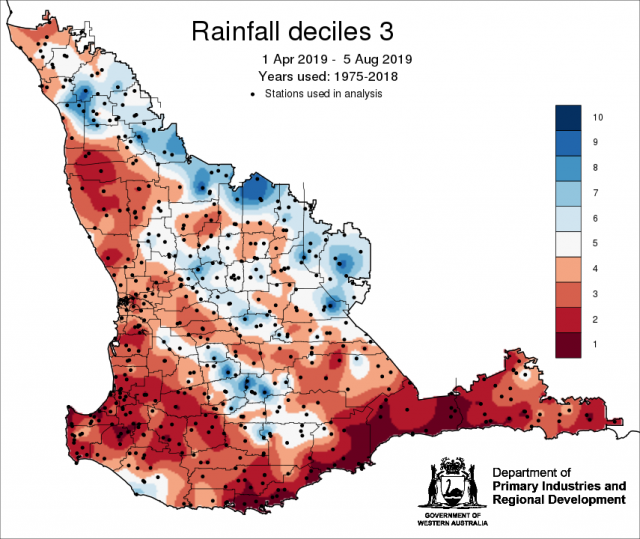Recent climate
July rainfall was below average to average in eastern parts.July maximum temperatures were above average and minimum temperatures were average to above average. Rainfall sice 1 April has been generally below deicle 5 for the SWLD with wetter areas in parts of the Central West and Central Wheatbelt (Bureau of Meteorology forecast districts).
In July, the atmospheric pressure was above normal over the SWLD suppressing cloud formation and to keep cold fronts further south than normal.
Indian Ocean sea surface temperatures off the WA coastline have been cooler than average. The August to October SST forecast by the Bureau of Meteorology indicates SSTs are likely to be near normal north of WA.
The Southern Annular Mode (SAM), also known as the Antarctic Oscillation (AAO), describes the north–south movement of the westerly wind belt that circles Antarctica, dominating the middle to higher latitudes of the southern hemisphere. For July, SAM was negative and is forecast to switch to positive, meaning the belt of westerly winds contracts towards Antarctica. This results in weaker than normal westerly winds and higher pressures over southern Australia, restricting the passage of cold fronts inland. Generally, this means that there are fewer rain events in winter for southern Australia.
Indian Ocean Dipole (IOD) index values have been near the threshold for a positive IOD in recent weeks. The broad pattern across the Indian Ocean has remained positive IOD-like, with warmer than average sea surface temperatures near Africa and cooler than average waters to Australia's northwest. Most climate models surveyed forecast positive IOD conditions for the remainder of winter and spring. Typically, a positive IOD brings below average winter–spring rainfall, above average temperatures, and an earlier start to the fire season for southern and central Australia.
The El Niño–Southern Oscillation (ENSO) is expected to remain neutral for the remainder of 2019. For further information, see the Bureau of Meteorology’s ENSO Wrap Up.
The table below gives a summary of past month and three-month South West Land Division (SWLD) climate conditions, and can indicate what is likely to occur in the near future if climate conditions follow the current pattern.
| Climate Indicator | Past month | Past 3 months |
|---|---|---|
| SWLD Rainfall | Below Average to average | mixed |
| SWLD Mean Temperature | Above Average | Average |
| SWLD atmospheric pressure | Near Normal | Above Normal |
| Indian Ocean Sea surface temperature | Cooler | Cooler |
| El Niño/Southern Oscillation (ENSO) | Neutral | Neutral |
| Indian Ocean Dipole (IOD) | Neutral | Neutral |
| Southern Annular Mode (SAM) | Negative | Positive |

